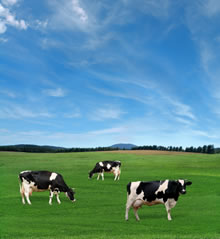Corn-Fed vs. Grass-Fed (Pastured) Beef

By Julie Hutsell, LAc
Did you even know that you had a choice? Until a few years ago, I didn’t. You hear so much about the delicious marbled beef from corn-fed cows, that I didn’t know we had other options. Actually, the choice matters immensely on several levels including health, environment, and ethics.
The old adage “you are what you eat” is particularly significant when it comes to corn-fed cows. Corn-fed cows may start their lives living on the green pasture eating grass; however, they end up in feed lots where they are fed corn for the majority of their lives. Now might be a good time to insert a minor detail: cows are HERBIVORES. Their stomachs are designed to digest grasses and corn is not a grass. So if cows cannot digest corn, how then, you may ask, are they fed corn? With lots and lots of medicine and medical intervention to keep them from getting sick; medicine like antibiotics and steroids so they can continue to be processed as meat. So, as a result of all of the doctoring the corn-fed cows undergo, their meat contains the antibiotics and steroids they are fed and consequentially, we eat them too. This is significant for the humans that eat them because there is evidence now that shows the widespread use of antibiotics in animals is leading to increased antibiotic-resistant strains of diseases in humans.
The environmental and ethical concerns come when we start discussing how the animals are kept. CAFO’s, or Concentrated Animal Feeding Operations, are the technical term for a feed lot. There the cows stand in piles of their own waste day in and day out. The waste from the CAFOS pollutes local water sources, and you can smell them for miles. The cows eat corn that was trucked in from sometimes hundreds or even thousands of miles away. Corn production also requires tons of petroleum energy; from the fertilizers, to the pesticides, to producing the seeds in the laboratories, and then trucking the seed to the farmers.
It’s a pretty stark contrast between the corn-fed cows and the grass-fed cows. Let’s look at the environmental and ethical consequences of raising and producing grass-fed beef. The food chain with pastured cows is very short and requires no petroleum. Grass-raised or pastured beef comes from cows allowed to live on the pasture all their lives. The term “grass” includes many varieties of grass and weeds such as clover, fescue, millet, bluegrass, thistles and Carolina nightshades.
The health benefits from these grasses are amazing. Meat from pastured cows has high amounts of omega 3 fatty acids and low levels of saturated fat. Grass-fed beef has higher amounts of omega-3s and fewer omega-6s than corn-fed beef; the ratio is 1:2, as opposed to 1:10 in corn-fed beef. You may be familiar with talk of omega-6 fatty acids and omega-3s. Health problems start to occur when the ratio of omega-6 fatty acids to omega-3 fatty acids gets out of proportion. Omega-6 fatty acids can have inflammatory effects on the body when not balanced by the omega-3s. This is likely one reason why we are now discovering the importance of omega-3s, because our diets have become so deficient in them over the last sixty years since our food system became industrialized and our meat started being corn-fed.
The bottom line is that the type of meat that we eat, be it fish, chicken, pork or beef, is less important than the food the animal itself has eaten. By eating grass- fed beef, not only will you be supporting your local farmer, you’ll be supporting your own good health. You can buy these meats at the local Farmer’s markets, at Weaver St. Market, and at Whole Foods. And for more information on this important subject, you can read either or both of these books by Michael Pollan: 'The Omnivore’s Dilemma' and 'In Defense of Food.' Being an informed consumer means considering the impact our food has on our bodies and on our world. There is a wealth of information out there to help you make healthy choices for yourself, your family and for your planet.


